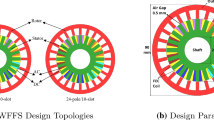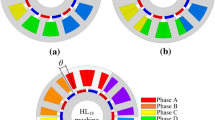Abstract
The multi-phase wound field flux switching (WFFS) machines achieved the advantages of the conventional FSPM machines and the common merits of multi-phase machines, e.g., low torque pulsations, high torque density and high fault tolerant capability. The non-overlapping windings can be used to minimize the consumption of copper and manufacturing costs for the WFFS machines. Hence, in this paper, five phase WFFS machines having the non-overlapping winding topology with four different rotor poles is presented. Ten slots with four different rotor pole designs namely 10S-12P, 10S-11P, 10S-9P, and 10S-8P are chosen to analyze the rotor pole study. The main section explains an essential overview of load and no-load analyses for five Phase WFFS machines and designs with different rotor poles are briefly compared. The proposed machine design studies are analyzed with five phase behavior of machine based on 2D-FEA. A detailed analysis of the proposed designs is also discussed like flux linkage, cogging torque, back EMF, THD, average torque versus current density, instantaneous torque, average torque versus stack length, copper losses, iron losses, efficiency and inductance calculations. The simulated results elaborate that the design with 11 rotor poles is best as it produces better back emf, higher torque and efficiency of 3.2 V, 1.65 Nm and 82.4% respectively.


















Similar content being viewed by others
References
El-Refaie AM, Jahns TM, Novotny DW (2006) Analysis of surface permanent magnet machines with fractional-slot concentrated windings. IEEE Trans Energy Convers 21(1):34–43
Cros J, Viarouge P (2002) Synthesis of high performance pm motors with concentrated windings. IEEE Trans Energy Convers 17(2):248–253
Boldea I, Tutelea LN, Parsa L, Dorrell D (2014) Automotive electric propulsion systems with reduced or no permanent magnets. An overview. IEEE Trans Ind Electron 61(10):5696–5711
Bash ML, Pekarek SD (2011) Modeling of salient-pole wound-rotor synchronous machines for population-based design. IEEE Trans Energy Convers 26(2):381–392
Zhang Z, Yan Y, Tao Y (2011) A new topology of low speed doubly salient brushless dc generator for wind power generation. IEEE Trans Magn 48(3):1227–1233
Fahimi B, Emadi A, Sepe RB (2004) A switched reluctance machine-based starter/alternator for more electric cars. IEEE Trans Energy Convers 19(1):116–124
Chiba A, Takano Y, Takeno M, Imakawa T, Hoshi N, Takemoto M, Ogasawara S (2011) Torque density and efficiency improvements of a switched reluctance motor without rare-earth material for hybrid vehicles. IEEE Trans Ind Appl 47(3):1240–1246
Levi EA (1995) Unified approach to main flux saturation modelling in dq axis models of induction machines. IEEE Trans Energy Convers 10(3):455–461
Matsuo T, Lipo TA (1994) Rotor design optimization of synchronous reluctance machine. IEEE Trans Energy Convers 9(2):359–365
Raminosoa T, Torrey DA, El-Refaie AM, Grace K, Pan D, Grubic S, Bodla K, Huh KK (2015) Sinusoidal reluctance machine with dc winding: an attractive nonpermanent-magnet option. IEEE Trans Ind Appl 52(3):2129–2137
Fan Y, Chau K, Niu S (2006) Development of a new brushless doubly fed doubly salient machine for wind power generation. IEEE Trans Magn 42(10):3455–3457
Cao R, Yuan X, Jin Y, Zhang Z (2018) Mw-class stator wound field flux-switching motor for semidirect drive wind power generation system. IEEE Trans Ind Electron 66(1):795–805
Sulaiman E, Kosaka T, Matsui N (2012) Design study and experimental analysis of wound field flux switching motor for hev applications. In: 2012 XXth international conference on electrical machines, Marseille, France, pp 1269–1275
Chen J, Zhu Z, Iwasaki S, Deodhar R (2010) Low cost flux-switching brushless ac machines. In: 2010 IEEE vehicle power and propulsion conference, Lille, France, pp 1–6
Raminosoa T, El-Refaie AM, Pan D, Huh KK, Alexander JP, Grace K, Grubic S, Galioto S, Reddy PB, Shen X (2015) Reduced rare-earth flux-switching machines for traction applications. IEEE Trans Ind Appl 51(4):2959–2971
Sulaiman E, Kosaka T, Matsui N (2011) A new structure of 12slot-10pole field-excitation flux switching synchronous machine for hybrid electric vehicles. In: Proceedings of the 2011 14th European conference on power electronics and applications, pp 1–10
Zhu Z, Wu Z, Evans D, Chu W (2014) A wound field switched flux machine with field and armature windings separately wound in double stators. IEEE Trans Energy Convers 30(2):772–783
Zulu A, Mecrow BC, Armstrong M (2010) A wound-field three-phase flux-switching synchronous motor with all excitation sources on the stator. IEEE Trans Ind Appl 46(6):2363–2371
Khan F, Sulaiman E, Ahmad M (2014) Coil test analysis of wound-field three-phase flux switching machine with non-overlapping winding and salient rotor. In: 2014 IEEE 8th international power engineering and optimization conference (PEOCO2014), Langkawi, Malaysia, pp. 243–247
Zhu Z, Zhou Y, Chen J, Green JE (2015) Investigation of nonoverlapping stator woundfield synchronous machines. IEEE Trans Energy Convers 30(4):1420–1427
Zhu Z, Liu X (2014) Novel stator electrically field excited synchronous machines without rare-earth magnet. In: 2014 Ninth international conference on ecological vehicles and renewable energies (EVER), pp. 1–13
Hua W, Su P, Tong M, Meng J (2016) Investigation of a five-phase e-core hybridexcitation flux-switching machine for ev and hev applications. IEEE Trans Ind Appl 53(1):124–133
Wang K, Gu Z, Liu C, Zhu Z (2018) Design and analysis of a five-phase spm machine considering third harmonic current injection. IEEE Trans Energy Convers 33(3):1108–1117
Wu Z, Zhu Z, Wang C, Mipo J, Personnaz S, Farah P (2018) Influence of dc winding configuration on its induced voltage in wound field machines. IEEE Trans Energy Convers 33(4):1825–1836
Wu Z, Zhu ZQ, Wang C, Mipo JC, Personnaz S, Farah P (2018) Reduction of opencircuit dc-winding-induced voltage in wound field switched flux machines by skewing. IEEE Trans Industr Electron 66(3):1715–1726
Wu Z, Zhu ZQ, Hua W, Akehurst S, Zhu X, Zhang W, Hu J, Li H, Zhu J (2019) Analysis and suppression of induced voltage pulsation in dc winding of five-phase wound-field switched flux machines. IEEE Trans Energy Convers 34(4):1890–1905
Ullah W, Khan F, Umair M (2029) Lumped parameter magnetic equivalent circuit model for design of segmented pm consequent pole flux switching machine. Engineering Computations.
Funding
No funding to declare.
Author information
Authors and Affiliations
Corresponding author
Ethics declarations
Conflict of interest
All authors have no conflict of interest to report.
Additional information
Publisher's Note
Springer Nature remains neutral with regard to jurisdictional claims in published maps and institutional affiliations.
Rights and permissions
About this article
Cite this article
Yousuf, M., Khan, F. & Ullah, B. Electromagnetic Performance of Five Phase Non-Overlapping Stator Wound Field Flux Switching Machine. J. Electr. Eng. Technol. 17, 371–380 (2022). https://doi.org/10.1007/s42835-021-00915-1
Received:
Revised:
Accepted:
Published:
Issue Date:
DOI: https://doi.org/10.1007/s42835-021-00915-1




